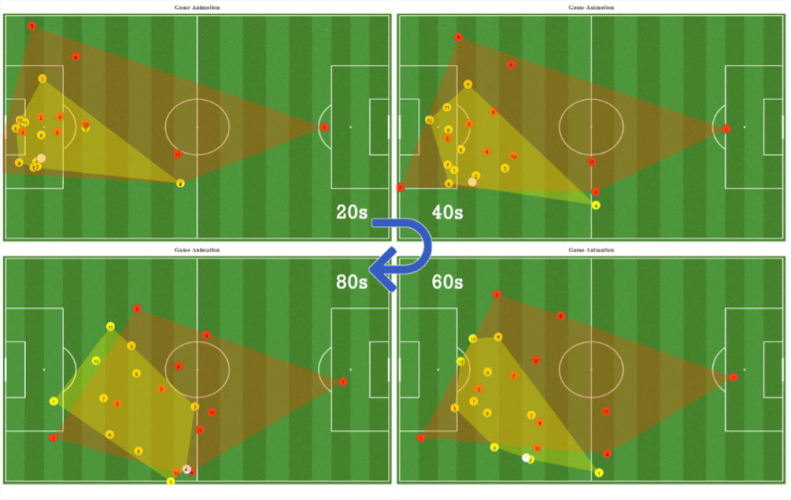Eye-tracking Research on GIS-Based Football Animation
 Convex hull animation (Nianhua Liu, 2022)
Convex hull animation (Nianhua Liu, 2022)Objective:
Keywords:
 Voronoi diagram animation (Nianhua Liu, 2022)
Voronoi diagram animation (Nianhua Liu, 2022)Description:
Playing in a specific space with limited time, football is considered as a sport dynamic process under spatio-temporal framework. In this kind of dynamic process, animation is a suitable visualization method. Coupling football animation together with the toolset of GIS can result in an advanced and intuitive medium, that allows users to easily perceive and understand the depicted phenomena.
GIS-based football animations are attracting increasing attention. While GIS tools bring more spatio-temporal information to football analysis, the user’s visual behavior and the information delivery effectiveness and efficiency of different GIS tools remain unclear.
The goal of this thesis is to evaluate and compare the effectiveness and efficiency of several GIS-based football animations. First, the students should clarify the usefulness of different GIS tools in football animation. Second, the student should investigate the relationship between the eye movement metrics of participants and the football information delivery effectiveness and efficiency. Finally, a user study and eye-tracking research should be conducted to evaluate the effectiveness and efficiency and compare user’s visual behavior of several animations.
Researchers working in this field: Nianhua Liu, M.Sc.
References:
- Coskun, A., & Cagiltay, K. (2022). A systematic review of eye-tracking-based research on animated multimedia learning. Journal of Computer Assisted Learning, 38(2), 581-598. https://doi.org/https://doi.org/10.1111/jcal.12629
- Cybulski, P. (2021). Effectiveness of Memorizing an Animated Route—Comparing Satellite and Road Map Differences in the Eye-Tracking Study. ISPRS International Journal of Geo-Information, 10(3), 159. https://www.mdpi.com/2220-9964/10/3/159
- Dong, W., Liao, H., Xu, F., Liu, Z., & Zhang, S. (2014). Using eye tracking to evaluate the usability of animated maps. Science China Earth Sciences, 57(3), 512-522. https://doi.org/10.1007/s11430-013-4685-3
- Kiefer, P., Giannopoulos, I., Raubal, M., & Duchowski, A. (2017). Eye tracking for spatial research: Cognition, computation, challenges. Spatial Cognition & Computation, 17(1-2), 1-19. https://doi.org/10.1080/13875868.2016.1254634
- Krassanakis, V., & Cybulski, P. (2021). Eye Tracking Research in Cartography: Looking into the Future. ISPRS International Journal of Geo-Information, 10(6), 411. https://www.mdpi.com/2220-9964/10/6/411
- Liu, N. (2022). GEOVISUALISATION OF FOOTBALL PLAYERS MOVEMENT. Olomouc. diplomová práce (Mgr.). UNIVERZITA PALACKÉHO V OLOMOUCI. Přírodovědecká fakulta
- Vanja, K., Plunkett, K., & Westermann, G. (2009). Eye-tracking study of animate objects. Psihologija, 42. https://doi.org/10.2298/PSI0903307K
Domain(s):
Study Program(s):
- MSc. Cartography (EXCLUSIVELY externally advertised)
